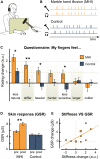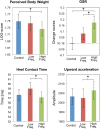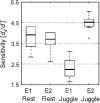The Influence of Auditory Cues on Bodily and Movement Perception
- PMID: 32010030
- PMCID: PMC6978806
- DOI: 10.3389/fpsyg.2019.03001
The Influence of Auditory Cues on Bodily and Movement Perception
Abstract
The sounds that result from our movement and that mark the outcome of our actions typically convey useful information concerning the state of our body and its movement, as well as providing pertinent information about the stimuli with which we are interacting. Here we review the rapidly growing literature investigating the influence of non-veridical auditory cues (i.e., inaccurate in terms of their context, timing, and/or spectral distribution) on multisensory body and action perception, and on motor behavior. Inaccurate auditory cues provide a unique opportunity to study cross-modal processes: the ability to detect the impact of each sense when they provide a slightly different message is greater. Additionally, given that similar cross-modal processes likely occur regardless of the accuracy or inaccuracy of sensory input, studying incongruent interactions are likely to also help us predict interactions between congruent inputs. The available research convincingly demonstrates that perceptions of the body, of movement, and of surface contact features (e.g., roughness) are influenced by the addition of non-veridical auditory cues. Moreover, auditory cues impact both motor behavior and emotional valence, the latter showing that sounds that are highly incongruent with the performed movement induce feelings of unpleasantness (perhaps associated with lower processing fluency). Such findings are relevant to the design of auditory cues associated with product interaction, and the use of auditory cues in sport performance and therapeutic situations given the impact on motor behavior.
Keywords: auditory; body perception; emotional valence; movement; multisensory integration; perception.
Copyright © 2020 Stanton and Spence.
Figures






Similar articles
-
Representation and integration of multiple sensory inputs in primate superior colliculus.J Neurophysiol. 1996 Aug;76(2):1246-66. doi: 10.1152/jn.1996.76.2.1246. J Neurophysiol. 1996. PMID: 8871234
-
Integration of somatosensory and motor-related information in the auditory system.Front Neurosci. 2022 Oct 18;16:1010211. doi: 10.3389/fnins.2022.1010211. eCollection 2022. Front Neurosci. 2022. PMID: 36330342 Free PMC article. Review.
-
Do infants represent human actions cross-modally? An ERP visual-auditory priming study.Biol Psychol. 2021 Mar;160:108047. doi: 10.1016/j.biopsycho.2021.108047. Epub 2021 Feb 14. Biol Psychol. 2021. PMID: 33596461
-
Integrating Visual Information into the Auditory Cortex Promotes Sound Discrimination through Choice-Related Multisensory Integration.J Neurosci. 2022 Nov 9;42(45):8556-8568. doi: 10.1523/JNEUROSCI.0793-22.2022. Epub 2022 Sep 23. J Neurosci. 2022. PMID: 36150889 Free PMC article.
-
Assessing the Role of Visual and Auditory Cues in Multisensory Perception of Flavor.In: Murray MM, Wallace MT, editors. The Neural Bases of Multisensory Processes. Boca Raton (FL): CRC Press/Taylor & Francis; 2012. Chapter 37. In: Murray MM, Wallace MT, editors. The Neural Bases of Multisensory Processes. Boca Raton (FL): CRC Press/Taylor & Francis; 2012. Chapter 37. PMID: 22593877 Free Books & Documents. Review.
Cited by
-
Body weight distortions in an auditory-driven body illusion in subclinical and clinical eating disorders.Sci Rep. 2022 Nov 21;12(1):20031. doi: 10.1038/s41598-022-24452-7. Sci Rep. 2022. PMID: 36414765 Free PMC article.
-
Increased risk of falls in older adults with hearing loss and slow gait: results from the Otassha Study.Geroscience. 2025 Apr;47(2):2235-2244. doi: 10.1007/s11357-024-01412-9. Epub 2024 Nov 1. Geroscience. 2025. PMID: 39485656 Free PMC article.
-
Exploring multisensory integration of non-naturalistic sounds on body perception in young females with eating disorders symptomatology: a study protocol.J Eat Disord. 2023 Feb 27;11(1):28. doi: 10.1186/s40337-023-00749-4. J Eat Disord. 2023. PMID: 36849992 Free PMC article.
-
A Perspective on Implementing Movement Sonification to Influence Movement (and Eventually Cognitive) Creativity.Front Psychol. 2020 Sep 18;11:2233. doi: 10.3389/fpsyg.2020.02233. eCollection 2020. Front Psychol. 2020. PMID: 33071849 Free PMC article.
-
Binaural Pulse Modulation (BPM) as an Adjunctive Treatment for Anxiety: A Pilot Study.Brain Sci. 2025 Jan 31;15(2):147. doi: 10.3390/brainsci15020147. Brain Sci. 2025. PMID: 40002480 Free PMC article.
References
-
- Agostini T., Righi G., Galmonte A., Bruno P. (2004). “The relevance of auditory information in optimizing hammer throwers performance,” in Biomechanics and Sports, ed. Pascolo P. B. (Vienna: Springer; ), 67–74. 10.1007/978-3-7091-2760-5_9 - DOI
-
- Andreasen A., Zovnercuka J., Konovalov K., Geronazzo M., Paisa R., Serafin S. (2018). “Navigate as a bat,” in Proceedings of the Real-time echolocation system in virtual reality, 15th Sound and Music Computing Conference, Limassol, 198–205.
Publication types
LinkOut - more resources
Full Text Sources

